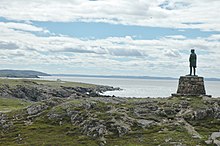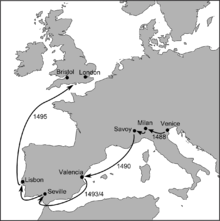He stepped out of the palace, and only then realized,
[that he would sail into the unknown and not have a destination.
On March the 5th, 1496,
[Henry VII gave John Cabot a declaration,
....... with the following charge of exploration:
...free authority, faculty and power to sail to all parts,
[regions and coasts of the eastern, western and northern sea,
under our banners, to find, discover and investigate new continents,
[as ancient Greeks were said, there are more than three.
The Greeks and the King were right,
[Cabot sailed to a new continent, one more,
the first European exploration of coastal North America,
[since the Norse visits (continent number four).
The First who visited the Australian coasts (1660) was a Dutch,
[Willem Janszoon..the existence of the fifth continent was a fact.
In 1773 James Cook crossed the Antarctic Circle,
[and reached close to 150 miles from Antarctica (untracked ?)
_________________________________________________________
* ''IT COULD BE OTHERWISE in verse''
Texts and Narration: Odysseus Heavilayias - ROTTERDAM //
Language adjustments and text adaptation: Kellene G Safis -CHICAGO//
Digital adaptation and text editing: Cathy Rapakoulia Mataraga - PIRAEUS
______________________________________________________________
 |
| A statue of John Cabot gazing across Bonavista Bay |
To mark the celebration of the 500th anniversary of Cabot's expedition, both the Canadian and British governments elected Cape Bonavista, Newfoundland, as representing Cabot's first landing site. However, alternative locations have also been proposed.
 |
| Cabot's travels around Europe, 1488–95 |
 | |
| Giovanni Caboto house in Venice |
* Continents, If you went to school in the United States, chances are you were taught that there are seven continents: Africa, Antarctica, Asia, Australia, Europe, North America, and South America.
In many parts of Europe, however, students are taught that there are only six continents, and teachers count North and South America as one continent.
Why the difference? From a geological perspective, Europe and Asia are one large landmass. Dividing them into two separate continents is more of a geopolitical consideration because Russia occupies so much of the Asian continent and historically has been politically isolated from the powers of Western Europe, such as Great Britain, Germany, and France.
Recently, some geologists have begun arguing that room should be made for a "new" continent called Zealandia. According to this theory, this landmass lies off the eastern coast of Australia. New Zealand and a few minor islands are the only peaks above water; the remaining 94 percent is submerged beneath the Pacific Ocean.
ELEGHOS... at history

No comments:
Post a Comment
Note: Only a member of this blog may post a comment.